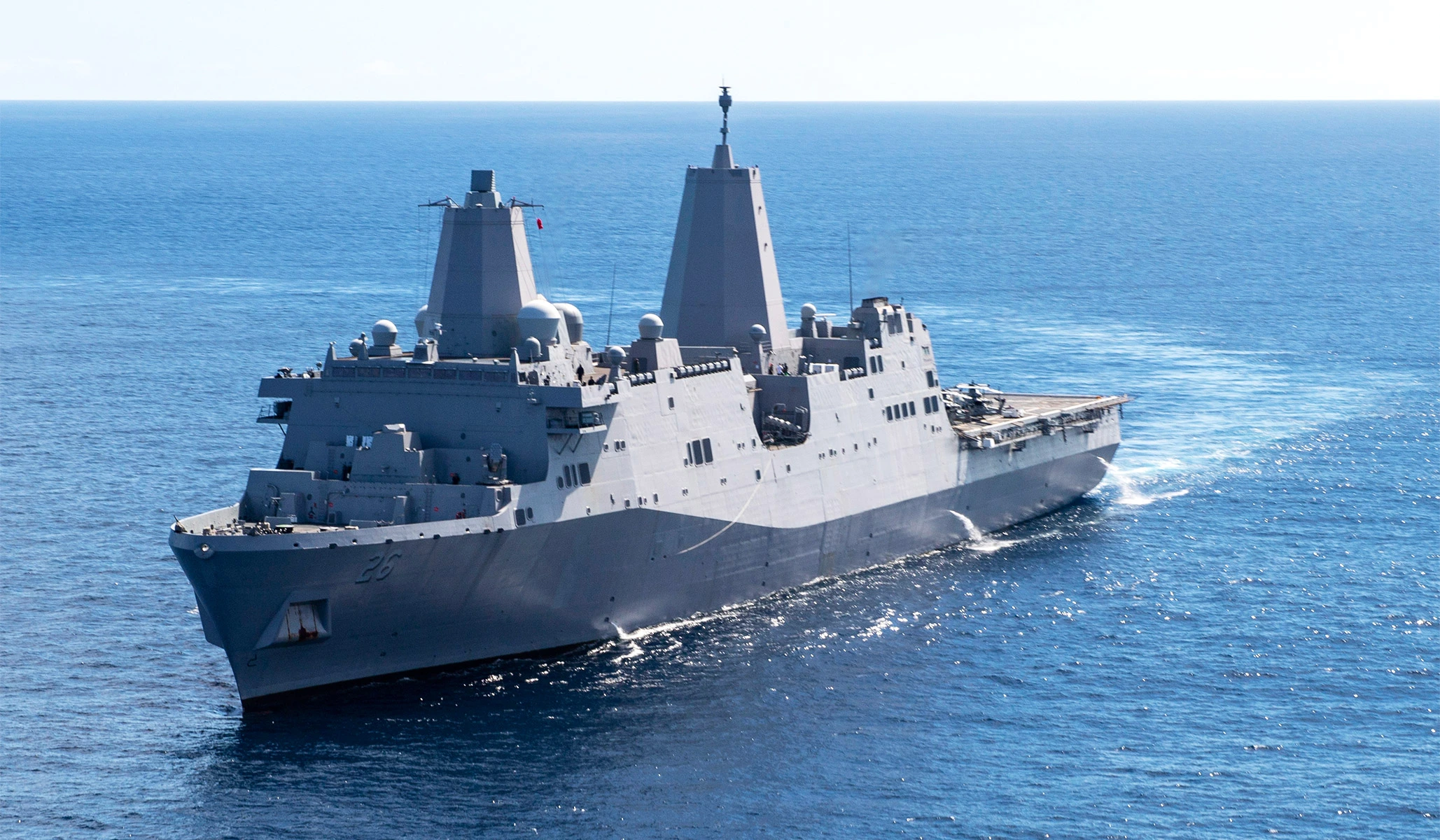As Congress considers the FY2024 National Defense Authorization Act (NDAA), the future of the Navy’s amphibious force, specifically the San Antonio-class Landing Platform Dock (LPD) ships, is a topic of great debate. Some argue that due to increasing costs, the LPDs should be reduced in complexity and size or have the construction timeline stretched to minimize their impact on the shipbuilding budget. However, there are reasons why LPD construction should cease altogether.
The first reason is that the United States Marine Corps needs to move on from its long-standing amphibious-assault strategy to remain relevant and survive as an institution and operational military force. The Marine Corps has not executed an amphibious assault against an opposed beach since the Inchon landing 73 years ago, and modern technology makes it unlikely that such assaults will occur in the future.
Both we and our adversaries know which beaches are suitable for amphibious assaults, and aspiring adversaries have invested in anti-access/area denial weapons to keep our Navy and Marine Corps forces away from their shores. These weapons include advanced sensors and highly lethal, long-range missiles. LPDs, as per their standard operating procedure, would unload their smaller amphibious-assault vehicles either within visual range or just beyond the visible horizon of the beach. However, both the larger ships and the smaller vehicles are detectable by radar and infra-red sensors, making them vulnerable to continuous traditional gunfire and long-range missile barrages before reaching the beach.
The war in Ukraine has demonstrated that nations with missiles will use them. While we acknowledge the heroism of the Marines and their willingness to sacrifice to achieve mission goals, the current state of anti-access sensors and weapons makes future opposed amphibious assaults highly risky.
The notion that large amphibious ships like LPDs can perform their intended missions, such as deploying small amphibious-assault craft and launching helicopters, in a high-end conflict is unrealistic. U.S. Navy aircraft carriers are already planning to operate beyond the first island chain under combat conditions and may need to move beyond the second island chain. These carriers have self-defense systems inherent in their air wing and surface combatant escorts, which the amphibious force lacks.
In war-gaming scenarios against China and Russia, the Marine Corps remains a critical player, but large-scale amphibious assaults are not essential capabilities. In a conflict with China, LPDs become liabilities that require multiple escorts, which would need to be diverted from more important missions. Marine Corps units equipped with anti-ship and land-attack missiles, positioned strategically in locations like Taiwan, Japan’s southern islands, and the Philippines, are game-changing assets. However, they must be delivered ahead of combat operations in a more permissive environment.
Proponents of LPDs argue that they are necessary for other missions, such as humanitarian assistance and troop and supply movements in lower-intensity conflicts. While this may be true, it is not cost-effective to spend nearly $2 billion per ship on LPDs that will only be used in non-combat scenarios. Other platforms designed to commercial standards can fulfill these missions. By reallocating half of the funds allocated for LPDs to alternative designs better suited to the Marine Corps’ likely missions, the other half could be directed towards other Navy shipbuilding programs that address high-end conflicts, such as submarines, destroyers, and unmanned vessels.
There have been indications of a shift in strategic direction from Marine Corps leadership, but alternative force-structure proposals have faced significant criticism. This pushback undermines reform efforts and jeopardizes necessary changes in the Navy’s force-structure investments to prepare for competition with China in the Indo-Pacific region.
General David Berger has attempted to introduce a new paradigm for the Marine Corps, focusing on smaller, lighter, technologically advanced, and agile units capable of operating independently in archipelagic waters and remote land bases. These units would counter China’s investments in anti-access/area denial weapons. Berger’s reforms have encountered resistance from retired Marine general officers and former government officials, who cling to outdated practices.
Berger initially supported reducing the number of larger, traditional amphibious-assault ships to free up funds for the development and procurement of lighter amphibious warships. However, he has since changed his stance to support an “all of the above” approach to Navy shipbuilding. This approach, combined with the Navy’s other shipbuilding requirements, makes it difficult to meet Berger’s competing demands, especially considering the challenge posed by China.
Shipbuilding shifts must be made to prepare the Navy for combat in the Western Pacific while preserving the industrial base in Mississippi and Alabama dedicated to LPD construction. New programs, such as Navy Medium Landing Ships (LSMs) for the Marine Corps and destroyers for the Navy, can be assigned to these shipyards to ensure a smooth transition with no gaps. It is crucial not to lay off vital shipyard workers, as they are strategically important. However, the argument that specific ships must continue to be built solely to retain workers should not hold sway. The threat of war with China is real, and the nation needs the right ships for the fight. The Navy, the industrial bases, and their supporters in Congress owe the taxpayer an honest and transparent accounting of the use of funds.
General Berger’s vision for the Marine Corps should be supported for its potential to create a strategic role that ensures the Corps’ relevance in the 21st century. This includes cutting ties with outdated practices. The Navy should back the construction of numerous new Navy Medium Landing Ship (LSM) platforms while ending the construction of older designs like LPDs to allocate funds towards new submarines and frigates.
Berger’s service should be extended, and he should be appointed as the next Commander of the Indo-Pacific Command in Hawaii, allowing him to take action on his initiatives. His successor, General Eric Smith, should adopt Berger’s bold vision, supported by Congress, while disregarding the voices of the past.

